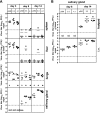Virus progeny of murine cytomegalovirus bacterial artificial chromosome pSM3fr show reduced growth in salivary Glands due to a fixed mutation of MCK-2
- PMID: 21813614
- PMCID: PMC3196435
- DOI: 10.1128/JVI.00545-11
Virus progeny of murine cytomegalovirus bacterial artificial chromosome pSM3fr show reduced growth in salivary Glands due to a fixed mutation of MCK-2
Abstract
Murine cytomegalovirus (MCMV) Smith strain has been cloned as a bacterial artificial chromosome (BAC) named pSM3fr and used for analysis of virus gene functions in vitro and in vivo. When sequencing the complete BAC genome, we identified a frameshift mutation within the open reading frame (ORF) encoding MCMV chemokine homologue MCK-2. This mutation would result in a truncated MCK-2 protein. When mice were infected with pSM3fr-derived virus, we observed reduced virus production in salivary glands, which could be reverted by repair of the frameshift mutation. When looking for the source of the mutation, we consistently found that virus stocks of cell culture-passaged MCMV Smith strain are mixtures of viruses with or without the MCK-2 mutation. We conclude that the MCK-2 mutation in the pSM3fr BAC is the result of clonal selection during the BAC cloning procedure.
Figures




Similar articles
-
Repair of an Attenuated Low-Passage Murine Cytomegalovirus Bacterial Artificial Chromosome Identifies a Novel Spliced Gene Essential for Salivary Gland Tropism.J Virol. 2020 Oct 27;94(22):e01456-20. doi: 10.1128/JVI.01456-20. Print 2020 Oct 27. J Virol. 2020. PMID: 32847854 Free PMC article.
-
Murine Cytomegalovirus MCK-2 Facilitates In Vivo Infection Transfer from Dendritic Cells to Salivary Gland Acinar Cells.J Virol. 2021 Aug 10;95(17):e0069321. doi: 10.1128/JVI.00693-21. Epub 2021 Aug 10. J Virol. 2021. PMID: 34132572 Free PMC article.
-
The r131 gene of rat cytomegalovirus encodes a proinflammatory CC chemokine homolog which is essential for the production of infectious virus in the salivary glands.Virus Genes. 2004 Aug;29(1):43-61. doi: 10.1023/B:VIRU.0000032788.53592.7c. Virus Genes. 2004. PMID: 15215683
-
Re-Analysis of the Widely Used Recombinant Murine Cytomegalovirus MCMV-m157luc Derived from the Bacmid pSM3fr Confirms Its Hybrid Nature.Int J Mol Sci. 2023 Sep 14;24(18):14102. doi: 10.3390/ijms241814102. Int J Mol Sci. 2023. PMID: 37762404 Free PMC article.
-
Genetic analyses of gene function and pathogenesis of murine cytomegalovirus by transposon-mediated mutagenesis.J Clin Virol. 2002 Aug;25 Suppl 2:S111-22. doi: 10.1016/s1386-6532(02)00096-3. J Clin Virol. 2002. PMID: 12361762 Review.
Cited by
-
A new reporter mouse cytomegalovirus reveals maintained immediate-early gene expression but poor virus replication in cycling liver sinusoidal endothelial cells.Virol J. 2013 Jun 17;10:197. doi: 10.1186/1743-422X-10-197. Virol J. 2013. PMID: 23773211 Free PMC article.
-
MCMV-based vaccine vectors expressing full-length viral proteins provide long-term humoral immune protection upon a single-shot vaccination.Cell Mol Immunol. 2022 Feb;19(2):234-244. doi: 10.1038/s41423-021-00814-5. Epub 2022 Jan 7. Cell Mol Immunol. 2022. PMID: 34992275 Free PMC article.
-
Peptide Processing Is Critical for T-Cell Memory Inflation and May Be Optimized to Improve Immune Protection by CMV-Based Vaccine Vectors.PLoS Pathog. 2016 Dec 15;12(12):e1006072. doi: 10.1371/journal.ppat.1006072. eCollection 2016 Dec. PLoS Pathog. 2016. PMID: 27977791 Free PMC article.
-
Murine cytomegalovirus virion-associated protein M45 mediates rapid NF-κB activation after infection.J Virol. 2014 Sep 1;88(17):9963-75. doi: 10.1128/JVI.00684-14. Epub 2014 Jun 18. J Virol. 2014. PMID: 24942588 Free PMC article.
-
Fine-tuning the evolutionary stability of recombinant herpesviral transmissible vaccines.Proc Biol Sci. 2024 Nov;291(2034):20241827. doi: 10.1098/rspb.2024.1827. Epub 2024 Nov 13. Proc Biol Sci. 2024. PMID: 39532136 Free PMC article.
References
-
- Ahasan M. M., Sweet C. 2007. Murine cytomegalovirus open reading frame m29.1 augments virus replication both in vitro and in vivo. J. Gen. Virol. 88:2941–2951 - PubMed
-
- Brune W., Menard C., Heesemann J., Koszinowski U. H. 2001. A ribonucleotide reductase homolog of cytomegalovirus and endothelial cell tropism. Science 291:303–305 - PubMed
Publication types
MeSH terms
Substances
Grants and funding
LinkOut - more resources
Full Text Sources

